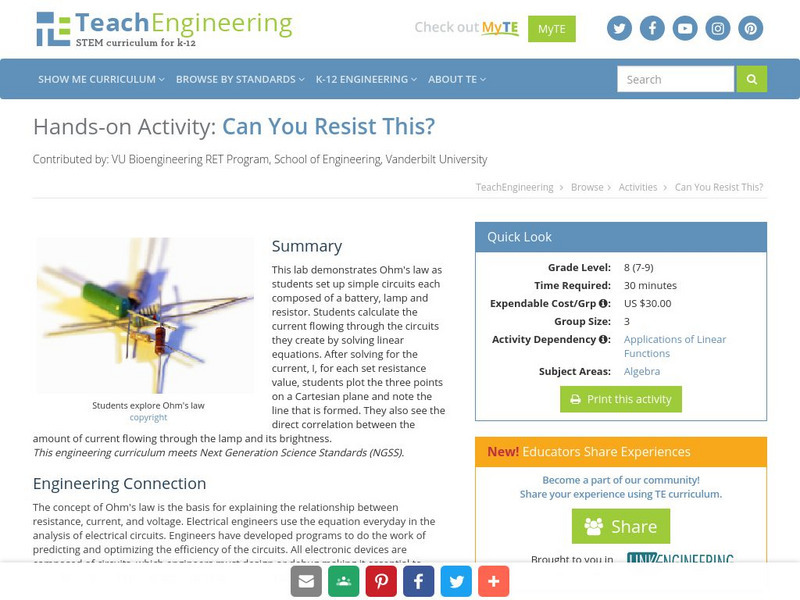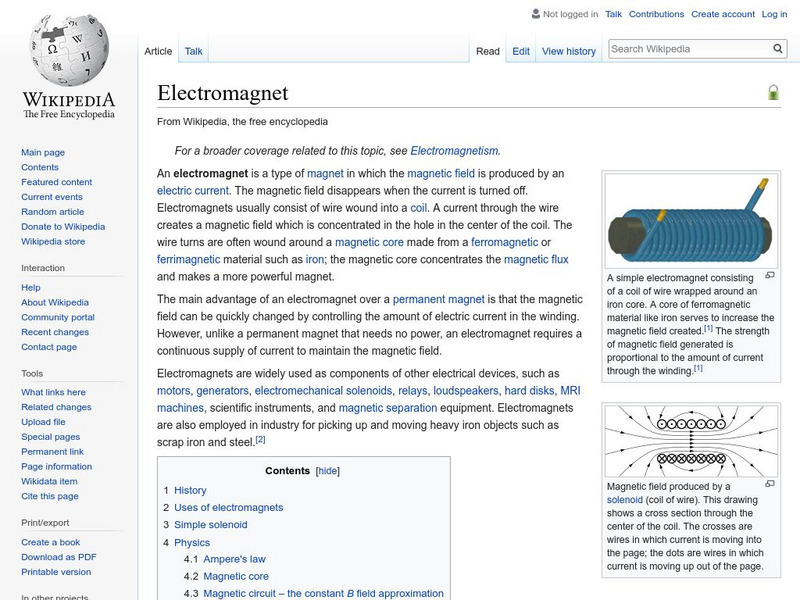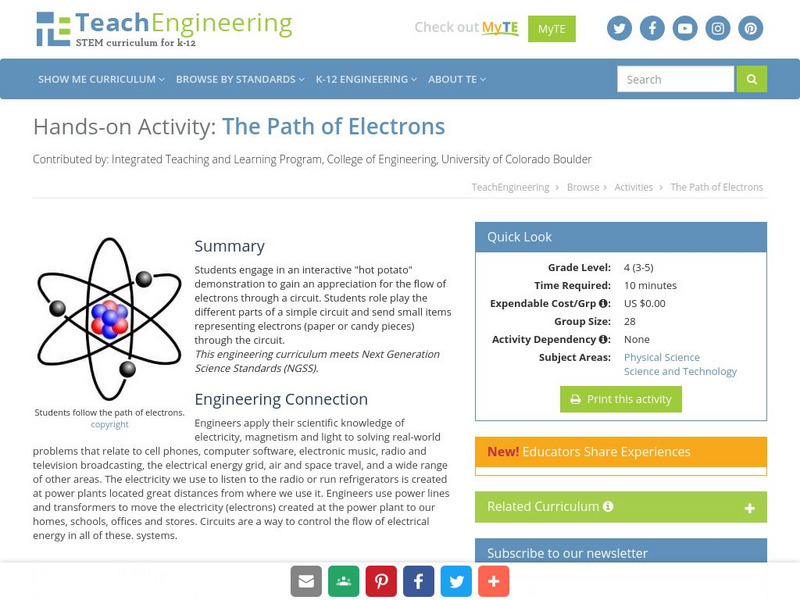Science and Mathematics Initiative for Learning Enhancement (SMILE)
Smile: Electron Current Flow
A teacher lesson plan which could be easily converted into an idea for a student project or presentation. This page describes an activity in which the water-electricity analogy is used to investigate the relationship between current,...
TeachEngineering
Teach Engineering: Can You Resist This?
This lab demonstrates Ohm's law as students set up simple circuits each composed of a battery, lamp and resistor. Students calculate the current flowing through the circuits they create by solving linear equations. After solving for the...
Project Britain
Primary Homework Help: Electricity Questions
Brush up on electricity facts before taking this interactive quiz. Students can get immediate feedback by checking the answers after each question.
Science Museum, London
Science Museum: Pocket Motor
Teacher directed activity shows students how flowing electrical current produces a magnetic field by building a simple motor.
TeachEngineering
Teach Engineering: Whose Field Line Is It, Anyway?
Students teams each use a bar magnet, sheet of paper and iron shavings to reveal the field lines as they travel around a magnet. They repeat the activity with an electromagnet made by wrapping thin wire around a nail and connecting...
TeachEngineering
Teach Engineering: Particle Sensing: The Coulter Counter
Students are presented with a short instructional activity on the Coulter principle, an electronic method to detect microscopic particles and determine their concentration in fluid. Depending on the focus of study, students can...
TryEngineering
Try Engineering: Electric Switches
Lesson focuses on how switches control the flow of electricity. Young scholars are posed with the challenge of designing and building a simple switch into an electric circuit.
BBC
Bbc: Gcse Bitesize: Mains Electricity and Alternating Current Aqa
This lesson focuses on Mains Electricity and Alternating Current. Electrical supplies can be direct current (DC) or alternating current (AC). The UK mains electricity supply is about 230V at 50 Hz. It explains the difference between AC...
Concord Consortium
Concord Consortium: Measuring Current on a Breadboard
Find out how measuring current in a circuit is like measuring the flow rate of water in a sprinkler system.
ClassFlow
Class Flow: Introduction to Power
[Free Registration/Login Required] This flipchart provides an introduction to electrical power to be used for AP Physics with calculus.
Wikimedia
Wikipedia: Electromagnet
Easy-to-read information and an illustration of an "electromagnet," a type of magnet in which the magnetic field is induced by the flow of an electric current.
Khan Academy
Khan Academy: Characteristics of Circuit Diagrams
Practice identifying the direction of current flow, closed circuits, and open circuits with this multiple choice quiz.
Science and Mathematics Initiative for Learning Enhancement (SMILE)
Smile: Series and Parallel Circuits
A teacher lesson plan which could be easily converted into an idea for a student project or presentation. Ideal for pre-high school pupils. This page describes an activity in which the history of electric circuits, the nature of electric...
TeachEngineering
Teach Engineering: The Path of Electrons
Students engage in an interactive "hot potato" demonstration to gain an appreciation for the flow of electrons through a circuit. Students role play the different parts of a simple circuit and send small items representing electrons...
Physics Aviary
Physics Aviary: Practice Problems: Current in a Wire Problem
Determine the resistance of a wire based on its composition and its physical dimensions. Find the current that would flow through the wire when the wire is connected to a certain voltage.
ClassFlow
Class Flow: Electricity
[Free Registration/Login Required] Students can use this Flipchart to learn and apply Ohm's law to basic circuitry problems. Students are introduced to the relationship among voltage, current, and resistance, and then apply their newly...
ClassFlow
Class Flow: Ohm's Law
[Free Registration/Login Required] A basic interactive lesson on Ohm's Law, I use this in my 9-12 CATE Electricity class.
TeachEngineering
Teach Engineering: Electrifying the World
This lesson introduces students to the fundamental concepts of electricity. This is accomplished by addressing questions such as "How is electricity generated," and "How is it used in every-day life?" The lesson also includes...
Science and Mathematics Initiative for Learning Enhancement (SMILE)
Smile: Resistances in Series and Parallel Circuits
A teacher lesson plan is provided here. This page describes two activities in which the effect of multiple resistors on the current and overall resistance of both series and parallel circuits are investigated. Complete activity...
CK-12 Foundation
Ck 12: Physics Simulation: Flashlight
[Free Registration/Login Required] Learn about electric circuits, the flow of current, electrical resistance, and electrical power dissipation by exploring the operation of a flashlight using this interactive simulation. A PDF worksheet...
Science Education Resource Center at Carleton College
Serc: How Do Light Bulbs Work?
A guided inquiry that involves observation of the parts of a light bulb in a lab.
National High Magnetic Field Laboratory
Magnet Academy: Georg Ohm
Georg Simon Ohm had humble roots and struggled financially throughout most of his life, but the German physicist is well known today for his formulation of a law, termed Ohm's law, describing the mathematical relationship between...
National High Magnetic Field Laboratory
Magnet Academy: Leon Cooper
Leon Cooper shared the 1972 Nobel Prize in Physics with John Bardeen and Robert Schrieffer, with whom he developed the first widely accepted theory of superconductivity. Termed the BCS theory, it is heavily based on a phenomenon known as...
Science and Mathematics Initiative for Learning Enhancement (SMILE)
Smile: Simple Circuitry and Series Circuit
A teacher lesson plan which could be easily converted into an idea for a student project or presentation. This page describes an activity in which the basic nature of a circuit and the concepts of a series circuit are investigated....



















